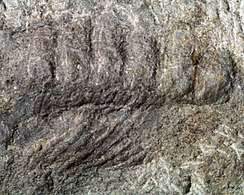Pneumodesmus
Pneumodesmus newmani is a species of millipede that lived in the Paleozoic. Its exact age is uncertain. It was originally interpreted as living 428 million years ago, in the Late Silurian;[1][2] however, the study conducted by Suarez et al. (2017) indicates that it actually lived in the Early Devonian (Lochkovian).[3] It is the first myriapod, and the oldest known creature to have lived on land.[4] It was discovered in 2004, and is known from a single specimen from Stonehaven, Aberdeenshire, Scotland.[2]
| Pneumodesmus | |
|---|---|
| Reconstruction of Pneumodesmus newmani | |
| Scientific classification | |
| Kingdom: | |
| Phylum: | |
| Subphylum: | |
| Class: | |
| Subclass: | |
| Order: | |
| Family: | |
| Genus: | Pneumodesmus |
| Species: | P. newmani |
| Binomial name | |
| Pneumodesmus newmani Wilson & Anderson, 2004 [1] | |

Discovery and naming
The fossil of P. newmani was found by Mike Newman, a bus driver and amateur palaeontologist from Aberdeen, in a layer of sandstone rocks on the foreshore of Cowie, near Stonehaven.[5] The species was later given the specific epithet "newmani" in honour of Newman. The holotype is kept in National Museum of Scotland, Edinburgh.[6] The genus name is said to derived from the Greek pneumato, meaning "air" or "breath",[1] in reference to the inferred air-breathing habit.[1] The proper word in ancient Greek for "air" or "breath" is however pneuma (πνεῦμα).[7]
Description
The single, 1 cm-long fragment of P. newmani depicts small paranota (keels) high on the body, long, slender legs. The dorsal portion of each body segment is ornamented with a horizontal bar and three rows of roughly hexagonal bosses (bumps).[1]
Significance
The fossil is important because its cuticle contains openings which are interpreted as spiracles, part of a gas exchange system that would only work in air. This makes P. newmani the earliest documented arthropod with a tracheal system, and indeed the first known oxygen-breathing animal on land.[4][8]
Trace fossils of myriapods are known dating back to the late Ordovician[1] (the geologic period preceding the Silurian), but P. newmani is the earliest body fossil of a millipede, and has been dated to 428 million years ago (late Wenlock epoch to early Ludlow epoch). The earliest centipedes follow some 10 million years later,[8] and the first known vertebrate on land, Tiktaalik, is 50 million years younger than Pneumodesmus.[9]
During the Silurian, the rocks that would later be part of Scotland were being laid down on the continent of Laurentia, in a tropical part of the Southern Hemisphere.[10]
References
- Heather M. Wilson & Lyall I. Anderson (2004). "Morphology and taxonomy of Paleozoic millipedes (Diplopoda: Chilognatha: Archipolypoda) from Scotland". Journal of Paleontology. 78 (1): 169–184. doi:10.1666/0022-3360(2004)078<0169:MATOPM>2.0.CO;2.
- "Fossil find 'oldest land animal'". BBC News. January 25, 2004.
- Stephanie E. Suarez; Michael E. Brookfield; Elizabeth J. Catlos; Daniel F. Stöckli (2017). "A U-Pb zircon age constraint on the oldest-recorded air-breathing land animal". PLoS ONE. 12 (6): e0179262. doi:10.1371/journal.pone.0179262. PMC 5489152. PMID 28658320.
- "Fossil millipede found to be oldest land creature". CNN (from Reuters). January 27, 2004.
- "Pneumodesmus newmani Exhibition". Stonehaven Guide. Archived from the original on December 24, 2016. Retrieved Oct 22, 2013.
- Paul Selden & Helen Read (2008). "The oldest land animals: Silurian millipedes from Scotland" (PDF). Bulletin of the British Myriapod & Isopod Group. 23: 36–37.
- Liddell, H.G. & Scott, R. (1940). A Greek-English Lexicon. Revised and augmented throughout by Sir Henry Stuart Jones. With the assistance of Roderick McKenzie. Oxford: Clarendon Press.
- Rowland Shelley & Paul Marek (March 1, 2005). "Millipede Fossils". East Carolina University. Archived from the original on May 27, 2011.
- David Winter (April 9, 2006). "When animals first conquered the land". Science and sensibility.
- "Cowie". BBC Scotland. Retrieved May 6, 2007.